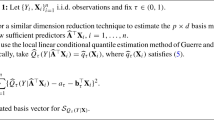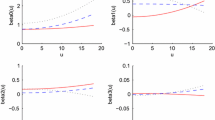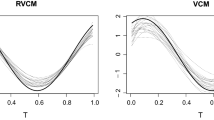Abstract
In practice, data often display heteroscedasticity, making quantile regression (QR) a more appropriate methodology. Modeling the data, while maintaining a flexible nonparametric fitting, requires smoothing over a high-dimensional space which might not be feasible when the number of the predictor variables is large. This problem makes necessary the use of dimension reduction techniques for conditional quantiles, which focus on extracting linear combinations of the predictor variables without losing any information about the conditional quantile. However, nonlinear features can achieve greater dimension reduction. We, therefore, present the first nonlinear extension of the linear algorithm for estimating the central quantile subspace (CQS) using kernel data. First, we describe the feature CQS within the framework of reproducing kernel Hilbert space, and second, we illustrate its performance through simulation examples and real data applications. Specifically, we emphasize on visualizing various aspects of the data structure using the first two feature extractors, and we highlight the ability to combine the proposed algorithm with classification and regression linear algorithms. The results show that the feature CQS is an effective kernel tool for performing nonlinear dimension reduction for conditional quantiles.



Similar content being viewed by others
References
Aizerman M, Braverman E, Rozonoer L (1964) Theoretical foundations of the potential function method in pattern recognition learning. Autom Remote Control 25:821–837
Akaho S (2001) Kernel method for canonical correlation analysis. In Proceedings of the international meeting of the psychometric society (IMPS2001)
Aronszajn N (1950) Theory of reproducing kernels. Trans Am Math Soc 68(3):337–404
Bach FR, Jordan MI (2002) Kernel independent component analysis. J Mach Learn Res 3:1–48
Baudat G, Annouar F (2000) Generalized discriminant analysis using a kernel approach. Neural Comput 12(10):2385–2404
Chaudhuri P (1991) Nonparametric estimates of regression quantiles and their local Bahadur representation. Ann Stat 19(2):760–777
Christou E (2020) Central quantile subspace. Stat Comput 30:677–695
Christou E, Akritas MG (2016) Single index quantile regression for heteroscedastic data. J Multivar Anal 150:169–182
Duan K, Keerthi SS, Poo AN (2003) Evaluation of simple performance measures for tuning SVM hyperparameters. Neurocomputing 51:41–59
Fukumizu K, Bach FR, Gretton A (2007) Statistical consistency of kernel canonical correlation analysis. J Mach Learn Res 8:361–383
Guerre E, Sabbah C (2012) Uniform bias study and Bahadur representation for local polynomial estimators of the conditional quantile function. Econom Theory 28(1):87–129
Harrison D, Rubinfeld DL (1978) Hedonic prices and the demand for clean air. J Environ Econ Manag 5:81–102
Hashem H, Vinciotti V, Alhamzawi R, Keming Y (2016) Quantile regression with group lasso for classification. Adv Data Anal Classif 10:375–390
Keerthi SS, Lin CJ (2003) Asymptotic behaviors of support vector machines with Gaussian kernel. Neural Comput 15:1667–1689
Koenker R, Bassett G (1978) Regression quantiles. Econometrica 46(1):33–50
Koenker R, Machado J (1999) Goodness of fit and related inference processes for quantile regression. J Am Stat Assoc 94(448):1296–1310
Kong E, Xia Y (2012) A single-index quantile regression model and its estimation. Econom Theory 28(4):730–768
Kong E, Xia Y (2014) An adaptive composite quantile approach to dimension reduction. Ann Stat 42(4):1657–1688
Kong E, Linton O, Xia Y (2010) Uniform Bahadur representation for local polynomial estimates of M-regression and its application to the additive model. Econom Theory 26(5):1529–1564
Kordas G (2006) Smoothed binary regression quantiles. J Appl Econ 21(3):387–407
Lai PL, Fyfe C (2000) Kernel and nonlinear canonical correlation analysis. Int J Neural Syst 10(5):365–377
Li KC (1991) Sliced inverse regression for dimension reduction. J Am Stat Assoc 86(414):316–327
Li B, Artemiou A, Li L (2011) Principal support vector machines for linear and nonlinear sufficient dimension reduction. Ann Stat 39(6):3182–3210
Luo W, Li B, Yin X (2014) On efficient dimension reduction with respect to a statistical functional of interest. Ann Stat 42(1):382–412
Mika S, Rätsch G, Weston J, Schölkopf B, Müller KR (1999) Fisher discriminant analysis with kernel. Proceed IEEE Neural Netw Signal Proc Workshop 9:41–48
Opsomer JD, Ruppert D (1998) A fully automated bandwidth selection method for fitting additive models. J Am Stat Assoc 93(442):605–619
Roth V, Steinhage V (2000) Nonlinear discriminant analysis using kernel functions. In advances in neural information processing systems, pages 568–574, MIT Press, Cambridge
Schölkopf B, Smola AJ, Müller KR (1998) Nonlinear component analysis as a kernel eigenvalue problem. Neural Comput 10(5):1299–1319
Schölkopf B, Smola AJ, Müller KR (1999) Kernel principal component analysis. Advances in kernel methods: support vector learning, pp. 327–352, MIT Press, Cambridge
Schölkopf B, Tsuda K, Vert JP (eds) (2004) Kernel methods in computational biology. MIT Press, Cambridge
Sigillito VG, Wing SP, Hutton LV, Baker KB (1989) Classification of radar returns from the ionosphere using neural networks. Johns Hopkins APL Tech Dig 10:262–266
Takeuchi I, Le QV, Sears T, Smola AJ (2006) Nonparametric quantile regression. J Mach Learn Res 7:1231–1264
Truong YK (1989) Asymptotic properties of kernel estimators based on local medians. Ann Stat 17(2):606–617
Wang C, Shin SJ, Wu Y (2018) Principal quantile regression for sufficient dimension reduction with heteroscedasticity. Electron J Stat 12:2114–2140
Wu HM (2008) Kernel sliced inverse regression with applications to classification. J Comput Graph Stat 17(3):590–610
Wu TZ, Yu K, Yu Y (2010) Single-index quantile regression. J Multivar Anal 101(7):1607–1621
Wu Q. Liang F, Mukherjee S (2013) Kernel sliced inverse regression: regularization and consistency. Abs Appl Anal, Volume 2013, Special Issue, Article ID 540725, 11 pages
Yeh YR, Huang SY, Lee YJ (2009) Nonlinear dimension reduction with kernel sliced inverse regression. IEEE Trans Knowl Data Eng 21(11):1590–1603
Yu K, Jones MC (1998) Local linear quantile regression. J Am Stat Assoc 93(441):228–237
Zhu LP, Zhu LX, Feng ZH (2010) Dimension reduction in regression through cumulative slicing estimation. J Am Stat Assoc 105(492):1455–1466
Acknowledgements
We wish to thank the authors of Hashem et al. (2016) for providing us the R code for performing group lasso for binary classification. We also want to thank the anonymous referees, whose comments lead to improvements in the presentation of this paper.
Author information
Authors and Affiliations
Corresponding author
Ethics declarations
Conflict of interest
The authors declare that they have no conflict of interest.
Additional information
Publisher's Note
Springer Nature remains neutral with regard to jurisdictional claims in published maps and institutional affiliations.
Rights and permissions
About this article
Cite this article
Christou, E., Settle, A. & Artemiou, A. Nonlinear dimension reduction for conditional quantiles. Adv Data Anal Classif 15, 937–956 (2021). https://doi.org/10.1007/s11634-021-00439-6
Received:
Revised:
Accepted:
Published:
Issue Date:
DOI: https://doi.org/10.1007/s11634-021-00439-6




